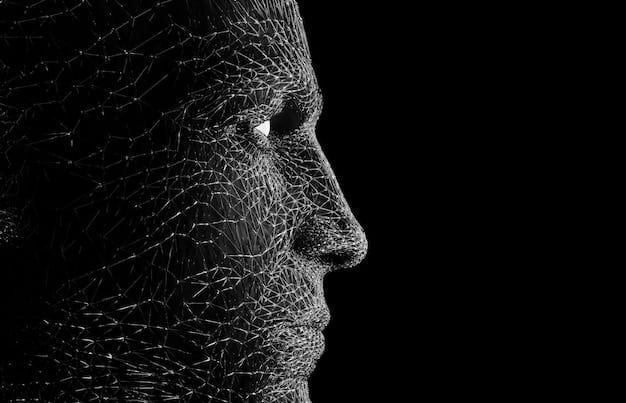Ethical Implications of Facial Recognition Tech in US

The ethical implications of facial recognition technology in the US span critical issues such as privacy erosion, bias in algorithmic systems, potential for mass surveillance leading to civil liberties infringements, and challenges in accountability for misuse, demanding urgent policy and regulatory frameworks.
In an increasingly digital world, the rapid advancement and deployment of facial recognition technology in the US have ignited a crucial debate surrounding its ethical implications. This powerful tool, capable of identifying or verifying individuals from digital images or video frames, presents a complex duality: a promise of enhanced security and convenience alongside profound concerns for individual liberties and societal equity.
The Erosion of Privacy and Consent
One of the most immediate and significant ethical concerns surrounding facial recognition technology in the United States is its profound impact on privacy. Unlike traditional forms of identification, facial data can be collected passively and often without explicit consent, leading to an insidious erosion of personal autonomy. Every public space, every shared image, every fleeting moment could potentially become a data point in a vast surveillance network.
The sheer scale of data collection achievable with facial recognition raises questions about the very nature of privacy in a modern society. When individuals can be identified and tracked without their knowledge or permission, the expectation of anonymity in public life diminishes significantly. This constant potential for monitoring can lead to a chilling effect on freedom of expression and assembly, as people may self-censor their activities or avoid certain places if they believe they are under constant observation.
The Scale of Data Collection
Facial recognition systems rely on vast databases of images and associated personal information. These databases are often compiled from various sources, including:
- Publicly available social media profiles
- Government-issued identification databases (e.g., driver’s licenses, passports)
- Surveillance camera footage from public and private entities
The aggregation of this data, often without clear consent mechanisms, creates a vulnerability. A single data breach could expose millions of sensitive biometric profiles, leading to unprecedented risks of identity theft and other malicious uses. Furthermore, the permanence of biometric data means that once exposed, it cannot simply be changed, unlike a compromised password.
The fundamental issue here lies in the concept of reasonable expectation of privacy. While individuals may have limited expectations of privacy in public spaces, the ability of technology to instantaneously catalog and identify them elevates this to a new level. The distinction between being seen by an individual and being systematically recorded and analyzed by an omnipresent system is critical.
This technology also challenges traditional notions of consent. Is merely being in a public place an implicit consent to have one’s biometric data collected and processed? Many argue that true consent requires informed notice and an opt-out mechanism, neither of which are typically present in widespread facial recognition deployments. Without robust legislative frameworks guaranteeing privacy rights, the individual’s control over their own likeness and personal data remains tenuous.
Bias and Discrimination in Algorithmic Systems
Another pressing ethical concern with facial recognition technology is its inherent susceptibility to bias and its potential to perpetuate or even amplify discrimination. Algorithmic bias is not a flaw; it is a reflection of the data used to train these systems. If the training data disproportionately represents certain demographics or is inadequate for others, the system’s accuracy will vary, leading to unequal and often unfair outcomes.
Numerous studies have demonstrated that facial recognition systems exhibit significantly higher error rates when identifying individuals from certain demographic groups, particularly women and people of color. This disparity in performance is not benign; it has tangible, negative consequences when these systems are deployed in real-world scenarios, especially in law enforcement and security contexts.
Real-World Impacts of Bias
The biased nature of these algorithms can lead to:
- False Arrests and Misidentifications: Individuals from underrepresented groups are more likely to be falsely identified as suspects, leading to wrongful arrests, investigations, and significant personal distress.
- Disproportionate Scrutiny: If the technology is less accurate for certain groups, it may lead to them being subjected to higher levels of surveillance and scrutiny, even when innocent. This exacerbates existing societal inequalities.
- Reinforcement of Stereotypes: When systems are designed or operate in ways that systematically disadvantage certain groups, they can reinforce harmful stereotypes and deepen mistrust in technology and institutions.
Addressing algorithmic bias requires a multi-faceted approach. It involves ensuring diverse and representative training datasets, developing robust testing methodologies to identify and mitigate biases, and implementing transparent auditing processes. However, even with these measures, complete elimination of bias is challenging, given the inherent complexities of human variability and the limitations of statistical models.
The ethical imperative here is to acknowledge that technology is not neutral. It carries the biases of its creators and the data it consumes. Therefore, deploying these systems without rigorously addressing their discriminatory potential is not only unethical but also poses a serious threat to social justice and equality. Accountability for biased outcomes must be clearly established, and mechanisms for redress must be readily available to those negatively impacted.
The Specter of Mass Surveillance and Civil Liberties
Beyond individual privacy, the widespread adoption of facial recognition technology raises profound concerns about the potential for mass surveillance and its implications for civil liberties. The ability to identify and track individuals in real-time, across vast networks of cameras, fundamentally alters the balance between state power and individual freedom. This capability goes far beyond traditional surveillance methods, enabling an unprecedented level of control and monitoring.
The fear is not just about catching criminals; it’s about the potential for governments or authoritarian regimes to monitor dissent, suppress peaceful protest, and exert undue control over the population. In a society where every movement in public spaces can be logged and analyzed, the courage to speak truth to power or engage in civil disobedience is significantly diminished.
Historical and Future Concerns
History is replete with examples of surveillance tools being misused, and facial recognition presents an even more potent risk due to its scalability and automation. Concerns include:
- Mission Creep: Technologies initially deployed for one purpose (e.g., finding missing persons) can gradually expand to other uses (e.g., monitoring political rallies), blurring ethical boundaries.
- Chilling Effect: The awareness of constant surveillance can lead individuals to self-censor their expressions, associations, and activities, thus undermining freedom of speech and assembly.
- Deterioration of Democracy: A population under constant digital watch may be less willing to challenge authority, leading to a less vibrant and critically engaged citizenry.

The Fourth Amendment of the US Constitution protects citizens from unreasonable searches and seizures. The argument is increasingly being made that passive, ubiquitous facial recognition constitutes an unreasonable search, as it collects highly personal data without probable cause or warrant. Legal frameworks are struggling to keep pace with technological advancements, leaving a significant gap in protecting constitutional rights.
Therefore, the ethical debate must move beyond mere regulation of usage to a more fundamental question: is pervasive facial recognition surveillance compatible with a free and open democratic society? Many civil liberties advocates argue that it is not, calling for outright bans or severe restrictions on its use by government agencies, particularly in real-time continuous monitoring of public spaces. The ethical balance leans heavily towards protecting the fundamental freedoms that define a democratic society, even at the perceived cost of enhanced security.
Accountability, Transparency, and Oversight Failures
A significant ethical challenge in the deployment of facial recognition technology lies in the lack of clear accountability, transparency, and robust oversight mechanisms. When systems are designed and implemented in opaque ways, it becomes incredibly difficult to understand how decisions are made, who is responsible for errors or misuse, and how individuals can seek redress if their rights are violated.
Currently, the landscape of facial recognition use in the US is fragmented, with varying policies and practices across federal, state, and local agencies, as well as by private entities. This patchwork approach hinders comprehensive oversight and creates opportunities for unchecked power and abuse. Without clear lines of responsibility, the technology can be deployed with insufficient consideration for its ethical ramifications or public implications.
Addressing the Lack of Control
Key areas where accountability and transparency are often lacking include:
- Algorithmic Black Boxes: Many advanced AI systems, including facial recognition, operate as “black boxes,” making it difficult to understand the logic behind their decisions. This opacity makes it challenging to identify and correct biases or errors.
- Lack of Public Disclosure: Agencies and companies often do not disclose where and how they use facial recognition, the specific systems they employ, or the data sources they rely upon. This secrecy prevents public scrutiny and informed debate.
- Insufficient Redress Mechanisms: If a person is misidentified or if their data is misused, there are often no clear and effective legal or administrative pathways for them to challenge the decision or seek compensation.
Ethically, any powerful technology with the potential for significant societal impact demands rigorous oversight. This includes independent audits of algorithmic performance, especially regarding bias, and clear legal frameworks that define permissible uses, prohibit discriminatory applications, and establish robust due process rights for individuals impacted by the technology. Without such measures, trust in both the technology and the institutions deploying it will erode.
Furthermore, accountability extends to the developers and vendors of facial recognition systems. There needs to be a legal and ethical expectation that these companies are responsible for the safe and ethical deployment of their products, including proactive measures to minimize bias and ensure data security. The current arms-race mentality in development, often prioritizing speed over ethical safeguards, must be re-evaluated in favor of a more deliberate and responsible approach.
Commercial Exploitation and Data Monetization
Beyond government use, the increasing commercial application of facial recognition technology presents its own unique set of ethical challenges, primarily centered on data monetization and consumer exploitation. Businesses are keen to leverage this technology for various purposes, from enhancing security and personalizing customer experiences to highly intrusive targeted advertising and behavioral analysis.
The ethical line blurs when biometric data, arguably one of the most sensitive forms of personal information, is collected, stored, and potentially sold or shared without explicit, informed consent. Consumers often interact with these systems unknowingly, whether entering a store with an integrated surveillance system or using a seemingly innocuous app that processes facial data.
Ethical Concerns in Commercial Use
The commercial exploitation of facial recognition data raises several ethical red flags:
- Covert Tracking: Retailers might use facial recognition to track customer movements, dwell times, and even emotional responses, building detailed profiles for targeted marketing without transparent disclosure.
- Behavioral Profiling: Analyzing facial expressions to infer mood or intent for commercial gain can be highly invasive and lead to discriminatory practices based on perceived emotions or demographics.
- Data Brokerage: The potential for companies to collect facial data and then sell it to third-party data brokers creates a vast, untraceable web of personal information, stripped of context and control.
The “terms and conditions” often associated with digital services frequently include broad clauses granting companies permission to collect and use user data, including biometric information, in ways that consumers may not fully comprehend. This implicit consent model is ethically dubious when dealing with such sensitive and unique identifiers that cannot be easily changed.
Ethical considerations demand that commercial entities implementing facial recognition be transparent about their practices, provide clear mechanisms for opting out, and ensure robust security measures to protect collected biometric data. Furthermore, the development of ethical guidelines and possibly even outright bans on certain commercial uses of facial recognition, especially those involving passive data collection for marketing and profiling, are becoming critical. The commodification of individual identity a deeply unsettling prospect, demanding stringent ethical and legal boundaries.
The Future Ethical Landscape: Regulation and Public Discourse
Given the multifaceted ethical implications of facial recognition technology, the path forward in the US requires a concerted effort toward comprehensive regulation and robust public discourse. The current piecemeal approach, with some states and cities implementing bans or restrictions while others have none, creates an inconsistent and often ineffective framework for addressing these complex issues.
Effective regulation must address key areas: defining permissible uses, establishing stringent consent requirements, ensuring algorithmic transparency and accountability, and creating avenues for redress. This also involves clarifying federal and state roles and responsibilities in governing this technology to avoid regulatory gaps or conflicts.
Pillars of Ethical Governance
A future ethical landscape would ideally be built upon:
- Explicit Legislation: Federal and state laws specifically regulating the development, deployment, and data handling practices of facial recognition technology across both public and private sectors.
- Independent Oversight Bodies: Creation of independent ethical review boards or governmental commissions with the power to audit systems, investigate complaints, and enforce regulations.
- Public Education and Engagement: Fostering widespread public understanding of how facial recognition works, its potential benefits and risks, and facilitating democratic participation in policy decisions.

The ethical implications are not merely legal or technical; they are fundamentally societal. The choice of how we integrate this technology reflects our values regarding privacy, civil liberties, and equality. Relying solely on industry self-regulation has proven insufficient in other areas of technology, and the sensitive nature of biometric data makes it especially unsuitable for such an approach.
Ultimately, striking a balance between innovation, security, and fundamental rights is paramount. This balance cannot be achieved without an informed public discourse that includes technologists, ethicists, legal scholars, civil liberties advocates, and the general citizenry. The ethical future of facial recognition in the US hinges on this collective societal deliberation and the political will to enact thoughtful, protective legislation that safeguards democratic values against the potential overreach of powerful technology.
| Key Ethical Point | Brief Description |
|---|---|
| 🕵️♂️ Privacy Erosion | Ubiquitous data collection without consent, leading to loss of anonymity and personal control. |
| ⚖️ Algorithmic Bias | Disparate accuracy rates affecting certain demographics, leading to discrimination and misidentification. |
| 🚨 Mass Surveillance | Potential for comprehensive tracking, chilling effect on civil liberties, and autocratic control. |
| 💸 Commercial Exploitation | Monetization of biometric data through covert tracking and behavioral profiling for profit. |
Frequently Asked Questions about Facial Recognition Ethics
▼
Facial recognition technology is a biometric artificial intelligence that identifies or verifies an individual’s identity using their face. It primarily works by analyzing unique facial features from images or video, converting them into digital data, and comparing them against a database of known faces to find a match. This technology is used across various sectors for security, convenience, and authentication purposes.
▼
It significantly erodes privacy by enabling passive, mass data collection without explicit consent. Individuals can be identified and tracked in public spaces, challenging the expectation of anonymity. This constant surveillance potential raises concerns about personal autonomy and data control, as biometric data, once collected, is irreversible and exceptionally sensitive.
▼
Algorithmic bias is a concern because facial recognition systems often exhibit higher error rates for certain demographic groups, particularly women and people of color. This bias, stemming from unrepresentative training data, can lead to disproportionate misidentifications, wrongful arrests, and discriminatory outcomes in applications like law enforcement, undermining fairness and equity.
▼
The ability to track individuals extensively can lead to a “chilling effect” on freedom of speech and assembly. People may self-censor or avoid certain activities if they believe they are under constant surveillance, potentially undermining democratic participation. This raises questions about the Fourth Amendment and the balance between security and fundamental constitutional rights.
▼
Efforts to address ethical concerns include calls for federal and state legislation, proposals for independent oversight bodies, and increased public discourse. Some cities and states have implemented bans or restrictions on facial recognition use by law enforcement. The goal is to establish clear legal frameworks for usage, consent, transparency, and accountability, balancing innovation with rights protection.
Conclusion
The intricate web of ethical implications surrounding facial recognition technology in the US demands urgent and comprehensive engagement. From the insidious erosion of privacy and the pervasive threat of algorithmic bias to the chilling specter of mass surveillance and the pressing need for accountability, these challenges underscore a critical juncture for society. Navigating this landscape requires careful consideration of individual rights, democratic values, and technological progress. Without robust legislative frameworks, transparent practices, and ongoing public discourse, the promise of facial recognition risks being overshadowed by its profound ethical costs. The ethical future of this powerful technology hinges on our collective commitment to safeguarding fundamental freedoms in the digital age.





